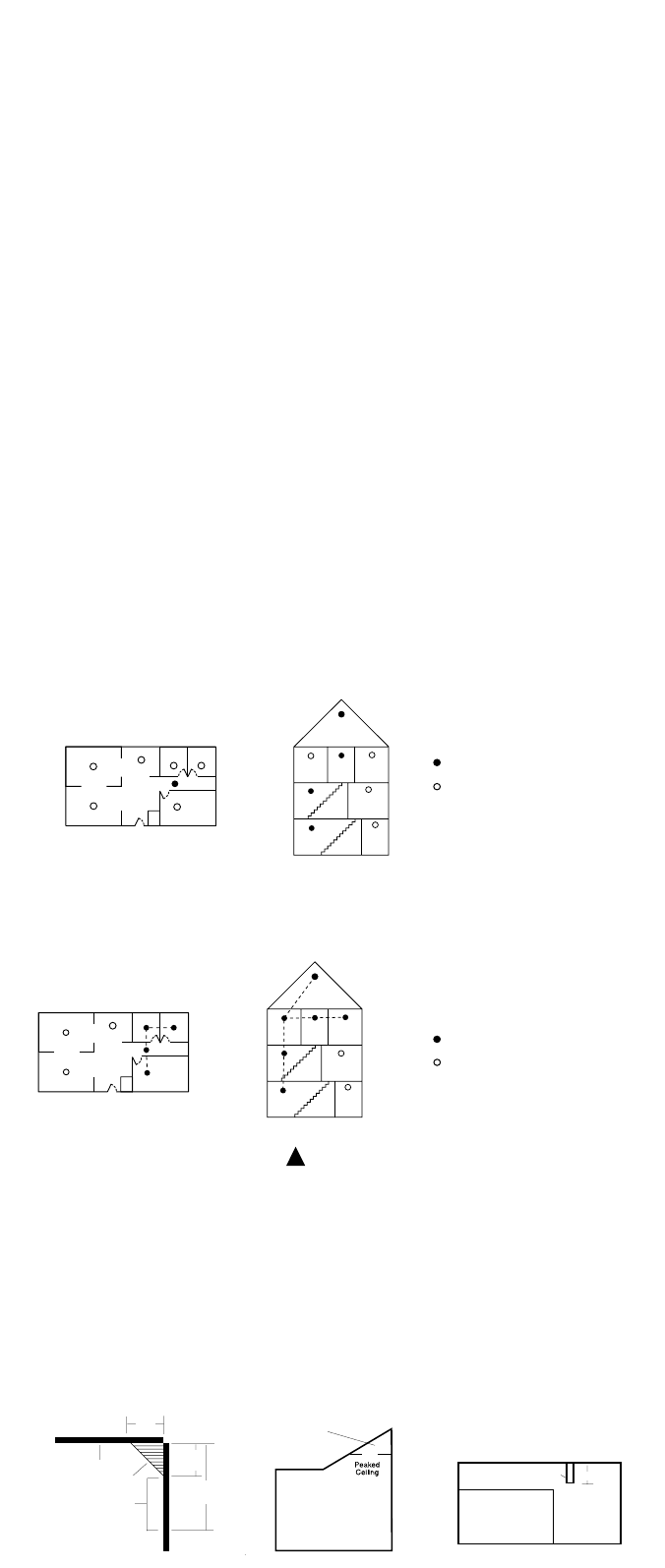
2
Proper Placement of Your Smoke Alarm
Invensys Controls Americas recommends complete coverage protection achieved by installing a smoke
alarm in every room of your home.
THIS EQUIPMENT SHOULD BE INSTALLED IN ACCORDANCE WITH THE NATIONAL FIRE PROTECTION
ASSOCIATION’S STANDARD 72 (National Fire Protection Association, Batterymarch Park, Quincy, MA
02269).
The NFPA standard identifies the minimum requirement for locating smoke alarms in family living units.
It states:
”2-2.1.1.1 Smoke alarms shall be installed outside of each separate sleeping area in the immediate vicinity
of the bedrooms and on each additional story of the family living unit including basements and excluding
crawl spaces and unfinished attics. In new construction, a smoke alarm also shall be installed in each
sleeping room.”
Further, section 2-2.2.1 states that:
“In new construction, where more than one smoke alarm is required by 2-2.1, they shall be so arranged that
operation of any smoke alarm shall cause the alarm in all smoke alarms within the dwelling to sound.”
The NFPA, 1993 Edition, Appendix A, however, clearly points out that:
“The required number of smoke alarms (as defined in the paragraphs above) may not provide reliable early
warning protection for those areas separated by a door from the areas protected by the required smoke
alarms. For this reason, it is recommended that the householder consider the use of additional smoke
alarms for those areas for increased protection. The additional areas include: basement, bedrooms, dining
room, furnace room, utility room, and hallways not protected by the required smoke alarms.”
Further, the California State Fire Marshal states that the minimum number of required smoke alarms is not
enough to give the earliest warning under all conditions. The California State Fire Marshal states that:
“Early warning fire detection is best achieved by the installation of fire detection equipment in all rooms and
areas of the household as follows: A smoke alarm installed in each separate sleeping area (in the vicinity, but
outside the bedrooms), and heat or smoke alarms in the living rooms, dining rooms, bedrooms, kitchens,
hallways, attics, furnace rooms, closets, utility and storage rooms, basements and attached garages.”
It is clear that the earliest warning of a developing fire is best achieved by the installation of smoke alarms in
all rooms and areas of the residence. Accordingly, Invensys Controls Americas recommends that you install
smoke alarms in every room of your residence—including basements and finished attics—even though this
is not required by the typical code or standard.
In addition, we recommend that you interconnect all smoke alarms capable of being interconnected. (The
smoke alarms referenced in this manual CANNOT be interconnected. Interconnectable Firex smoke alarms
include models G, GC, AD, ADC, FADC, PAD and PG.)
Invensys Controls Americas recommends a minimum of two smoke alarms in every home, no matter how
small the home (including efficiency apartments). Invensys Controls Americas also recommends maximum
coverage by installing smoke alarms in both required and recommended locations as illustrated and
described hereafter.
Existing Homes:
The NFPA requires a smoke alarm on every level and outside each sleeping area in existing construction.
An existing household with one level and one sleeping area is required to have one smoke alarm.z
New Construction Homes:
The NFPA requires AC-powered, interconnected smoke alarms to be installed inside each bedroom,
outside each bedroom area, and on every level of the home. They also require a minimum of two AC-
powered, interconnected smoke alarms in any new construction home.
Model CB, CC, CEC, CPBC and CCPB smoke alarms DO NOT meet NFPA minimum
requirements for new construction. Use these models only in recommended
smoke alarm locations.
Mobile Home Installation
• For minimum protection, smoke alarms should be installed in compliance with H.U.D. Manufactured
Home Construction Safety Standards Title 24 CFR, Section 3280.208 and Section 3282.
• For additional protection, see single-story residence smoke alarm requirements and
recommendations for existing homes and new construction.
NOTE: For mobile homes built before 1978, install smoke alarms on inside walls between
4 and 12 inches from the ceiling (older mobile homes have little or no insulation in the ceiling). This is
especially important if the ceiling is unusually hot or cold.
Additional Smoke Alarm Placement Information
Key
NFPA minimum REQUIRED smoke
alarm locations
Invensys Controls Americas recommend-
ed additional smoke alarm locations
TWO STORY RESI-
DENCE
LIVING
ROOM
BASEMENT
KITCHEN
UTILITY
ROOM
HALL
BEDROOM
BEDROOM
FINISHED
ATTIC
EXISTING HOMES
BEDROOM
KITCHEN
DINING
ROOM
BEDROOM
LIVING
ROOM
BEDROOM
TWO STORY RESI-
DENCE
LIVING
ROOM
BASEMENT
UTILITY
ROOM
KITCHEN
FINISHED
ATTIC
BEDROOM
BEDROOM
HALL
SINGLE STORY RESIDENCE/
APARTMENT/MOBILE HOME
BEDROOM
KITCHEN
DINING
ROOM
BEDROOM
LIVING
ROOM
BEDROOM
NEW CONSTRUCTION
Key
NFPA minimum REQUIRED smoke
alarm locations
Invensys Controls Americas recommended
additional smoke alarm locations
---- Denotes interconnection
WARNING
!
3'0
SOFFIT
SUBWALL
24"
•
•
•
ACCEPTABLE
HERE
CEILING
ACCEPTABLE HERE
NEVER HERE
TOP OF DETECTOR
ACCEPTABLE HERE
SIDE
WALL
•
•
•
•
4 IN.
(O.1M)
•
•
4 IN.
(O.1M)
MINIMUM
12 IN.
(O.3M)
MAXIMUM
•
•
110-1011E English 12/12/06 10:10 AM Page 2








